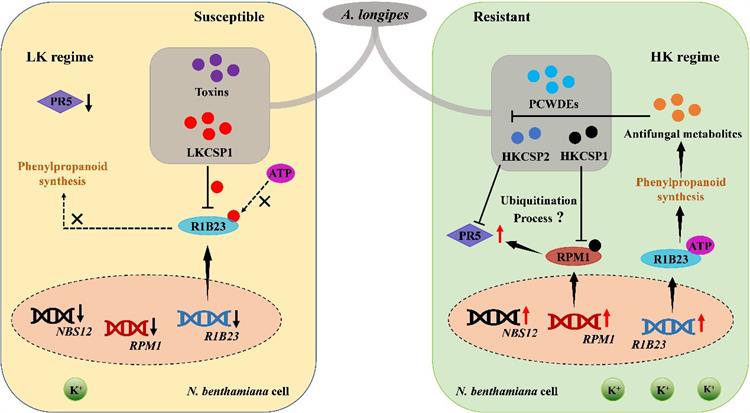Recently, the R&D Team for Fungal Diversity and Fungal Disease Control from our college has just made new progress in potassium nutrition regulation of immunity and the mechanism of promoting plant disease resistance. The related research, titled Changes in planta K nutrient content altered the interaction pattern between Nicotiana benthamiana and Alternaria longipes was published in the journal Plant, Cell & Environment. Doctoral students, Du Youwei, Liu Guangli, and Jia Hongchen from our college are the co-first authors of this paper, while Prof. Sun Guangyu and Associate Prof. Liang Xiaofei are the co-corresponding authors.
Potassium, as a macronutrient in plants, affects plant growth and development and plays an important role in enhancing plant disease resistance. Rational utilization of potassium fertilizer can enhance the resistance of crops to a large number of pathogens. For instance, under sufficient potassium (high potassium) levels, the resistance of apple trees to decay pathogens reaches nearly immune levels. However, the mechanism of how potassium nutrition promotes plant immunity and affects the interaction pattern between plants and pathogens is still unclear.
This study focused on the tobacco brown spot disease system, analyzing the dynamic interaction patterns between pathogens and plants under different potassium levels. It was found that plants and pathogens adopted different strategies to compete with each other in plants with different potassium contents. Under high potassium conditions, tobacco mainly activates the expression of NLRs family immune proteins NbRPM1, NbR1B23, and NbNBS12 when infected by the brown spot pathogen, increasing the expression of disease-related proteins, promoting the burst of reactive oxygen species and the synthesis and accumulation of antibacterial metabolites, inhibiting the infection and spread of pathogens. When infecting low-potassium tobacco, the pathogen inhibits plant resistance by increasing the expression of toxin-related genes and mobilizing the secretory protein LKCSP to interact with NbR1B23. However, when infecting high-potassium tobacco, it inhibits plant disease resistance by increasing the expression of cell wall-degrading enzyme-related genes and mobilizing secretory proteins HKCSP1 and HKCSP2 to interact with NbRPM1 and PR5, respectively. The result of the competition between the two is that the pathogen prevails under low potassium, successfully infecting and causing severe disease, while the host plant prevails over the pathogen under high potassium, significantly enhancing disease resistance and effectively resisting pathogen damage. This study discovered a new mechanism of potassium enhancing plant immunity and mapped a new landscape of plant-pathogen competition under different potassium nutrition conditions, providing new insights into the theory of plant nutrient elements affecting the "arms race" between plants and pathogens.

Diagram of plant-pathogen interaction patterns under different potassium nutrition levels
This research was funded by the National Key R&D Program of China, the National Natural Science Foundation of China, and the National Apple Modern Industrial Technology System.
Original Link:https://onlinelibrary.wiley.com/doi/10.1111/pce.14956